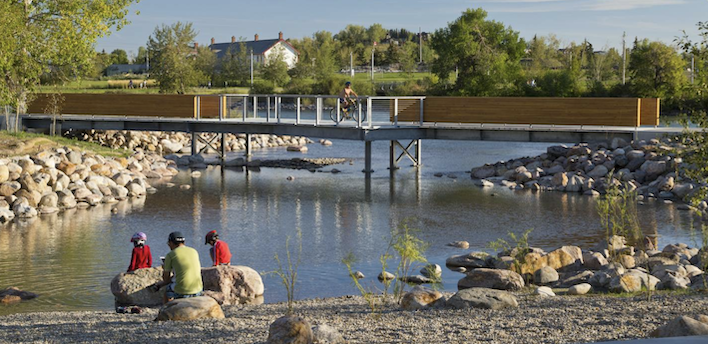Improving connectivity and sustainability through pedestrian bridge design
- Details

Bridges play a critical role in society and in our communities, they are more than just simple crossing points or entranceways. They have the potential to be iconic works of functional art, direct and purposeful expressions of structure, and can connect people, places, and nature to allow our communities to function and thrive. Providing a safe and efficient way for pedestrians to cross over traffic, rivers, or other obstacles is just the beginning. Beautifully designed pedestrian bridges also enrich and enhance their surroundings.
New designs of bridges reflect shifting attitudes of the modern period where people expect buildings, bridges, spaces, and structures to serve more than a singular purpose. As a result, there will be a continued shift in prevalence to pedestrian bridge designs that improve a city or community’s connectivity while promoting sustainability.
Pedestrian bridges not only allow traffic to run more smoothly, but also help reduce vehicle fuel consumption and emission exhaust. Another key sustainability factor in bridge design is longevity. While its unlikely that climate change and sustainability were at the forefront of early-AD Roman engineers’ concerns, their durable works have inspired modern engineers and stand as a prime example of production of structures that stand the test of time, adapting to new uses if necessary.
Bridges connect destinations in communities and provide access to emergency and essential services but can often be pinch points in a road network. Bridges that lack pedestrian or bicycle accommodations can force detours or sever routes entirely, eliminating or discouraging the option to walk or bike for transportation. Pedestrian bridges provide an alternative route to free up traffic, thereby improving safety, and give pedestrians a safer and comfortable connection to schools, workplaces, parks, healthcare services, and other destinations to increase a city’s connectivity.
According to RJC Engineers’ Geoff Kallweit, by placing the bridge appropriately, the design team was able to introduce five points of access with better connectivity to transit, bike routes, and desirable destinations in the area. By locating the bridge sufficiently away from the existing span, it became possible to build the new bridge without demolishing the old one, allowing for current pedestrian routes to continue unaffected and enhance the sustainability of the project.
A pedestrian bridge should be both welcoming and functional, allowing safe and comfortable passage for pedestrians. Just because they’re smaller in size than bridges meant for automobiles, they are not smaller in their impact and design. As the trend continues, cities will look to implement pedestrian bridge designs that promote connectivity and sustainability.
New designs of bridges reflect shifting attitudes of the modern period where people expect buildings, bridges, spaces, and structures to serve more than a singular purpose. As a result, there will be a continued shift in prevalence to pedestrian bridge designs that improve a city or community’s connectivity while promoting sustainability.
Pedestrian bridge design for enhanced connectivity and sustainability
Pedestrian bridges not only allow traffic to run more smoothly, but also help reduce vehicle fuel consumption and emission exhaust. Another key sustainability factor in bridge design is longevity. While its unlikely that climate change and sustainability were at the forefront of early-AD Roman engineers’ concerns, their durable works have inspired modern engineers and stand as a prime example of production of structures that stand the test of time, adapting to new uses if necessary.
Bridges connect destinations in communities and provide access to emergency and essential services but can often be pinch points in a road network. Bridges that lack pedestrian or bicycle accommodations can force detours or sever routes entirely, eliminating or discouraging the option to walk or bike for transportation. Pedestrian bridges provide an alternative route to free up traffic, thereby improving safety, and give pedestrians a safer and comfortable connection to schools, workplaces, parks, healthcare services, and other destinations to increase a city’s connectivity.
A view of the Westbrook pedestrian bridge
The Westbrook pedestrian bridge replacement project was initiated by the City of Calgary as part of a program to rebuild key pedestrian crossings across the city where the existing structure was in disrepair and sub-standard in several ways. When RJC Engineers was awarded the contract to design the bridge replacement, the placement of the new span was reconsidered to leverage two opportunities: improvements to bridge access locations, and an alignment that would avoid detours.According to RJC Engineers’ Geoff Kallweit, by placing the bridge appropriately, the design team was able to introduce five points of access with better connectivity to transit, bike routes, and desirable destinations in the area. By locating the bridge sufficiently away from the existing span, it became possible to build the new bridge without demolishing the old one, allowing for current pedestrian routes to continue unaffected and enhance the sustainability of the project.
A pedestrian bridge should be both welcoming and functional, allowing safe and comfortable passage for pedestrians. Just because they’re smaller in size than bridges meant for automobiles, they are not smaller in their impact and design. As the trend continues, cities will look to implement pedestrian bridge designs that promote connectivity and sustainability.